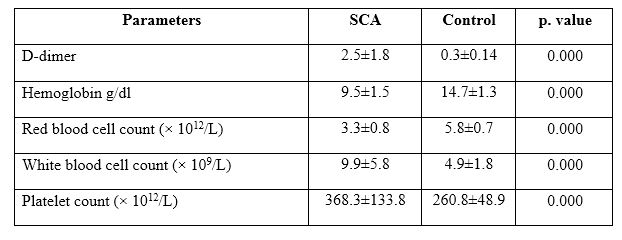Assessment of D-dimer level among Yemeni Patients with Sickle Cell Anemia
Main Article Content
Abstract
Background: Sickle cell anemia (SCA) is a hereditary hemoglobin disorder characterized by chronic hemolysis, vaso-occlusive crises, and a hypercoagulable state. Elevated D-dimer levels have been associated with increased thrombotic risk in patients with SCA. However, limited data exists on D-dimer levels in Yemeni patients with SCA.
Objective: This study aimed to assess the plasma D-dimer levels in Yemeni patients with SCA and compare them with those of healthy controls.
Methods: A comparative cross-sectional study was conducted at the Yemen Society for Thalassemia and Genetic Blood Disorders in Sana'a, Yemen from August to December 2024. The study included 100 participants: 50 patients with SCA and 50 age- and sex-matched healthy controls. The plasma D-dimer levels were measured using an automated immunoturbidimetric assay. Hematological parameters were analyzed using an automated hematology analyzer. Statistical analysis was performed using SPSS version 26, and a p-value of <0.05 was considered significant.
Results: The mean D-dimer level in SCA patients was significantly higher (2.5±1.8 mg/L) compared to the control group (0.3±0.14 mg/L) (p=0.000). Hemoglobin levels were significantly lower in the SCA group (9.5±1.5 g/dL) compared to controls (14.7±1.3 g/dL) (p=0.000). SCA patients also exhibited significantly lower RBC counts (3.3±0.8 ×10¹²/L) and higher platelet counts (368.3±133.8 ×10⁹/L) than controls (5.8±0.7 ×10¹²/L and 260.8±48.9 ×10⁹/L, respectively) (p=0.000).
Conclusion: Yemeni patients with SCA exhibited significantly elevated D-dimer levels, suggesting increased coagulation activation and thrombotic risk. These findings highlight the need for further research on thromboprophylactic strategies in this population.
Downloads
Article Details

This work is licensed under a Creative Commons Attribution-NonCommercial-NoDerivatives 4.0 International License.

